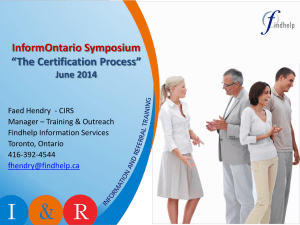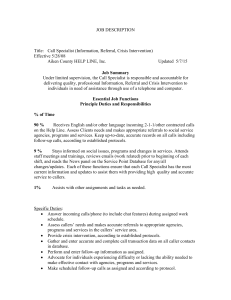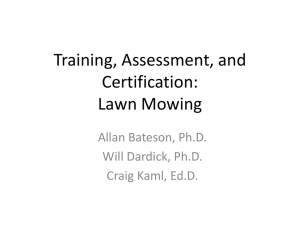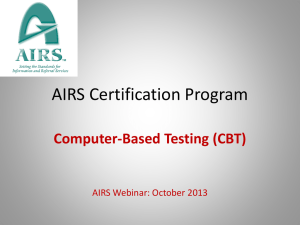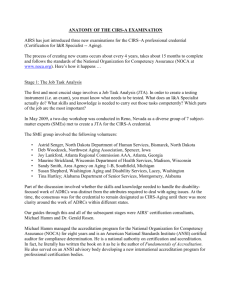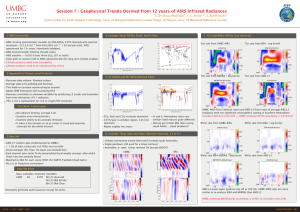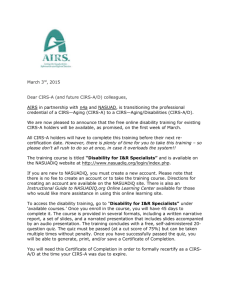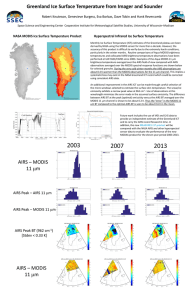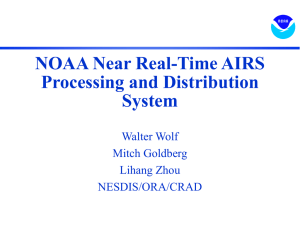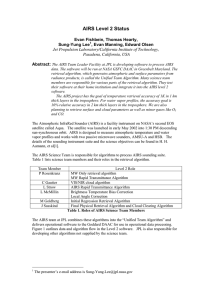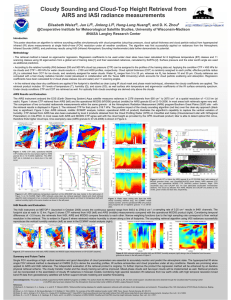CRS EXAM STORY
advertisement
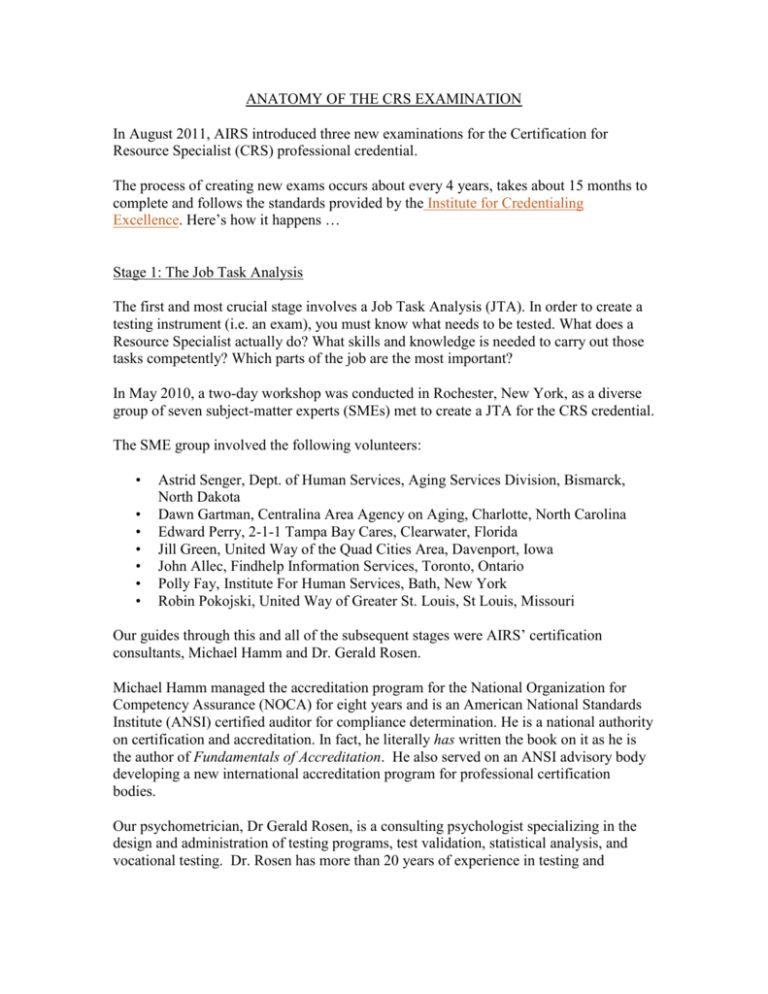
ANATOMY OF THE CRS EXAMINATION In August 2011, AIRS introduced three new examinations for the Certification for Resource Specialist (CRS) professional credential. The process of creating new exams occurs about every 4 years, takes about 15 months to complete and follows the standards provided by the Institute for Credentialing Excellence. Here’s how it happens … Stage 1: The Job Task Analysis The first and most crucial stage involves a Job Task Analysis (JTA). In order to create a testing instrument (i.e. an exam), you must know what needs to be tested. What does a Resource Specialist actually do? What skills and knowledge is needed to carry out those tasks competently? Which parts of the job are the most important? In May 2010, a two-day workshop was conducted in Rochester, New York, as a diverse group of seven subject-matter experts (SMEs) met to create a JTA for the CRS credential. The SME group involved the following volunteers: • • • • • • • Astrid Senger, Dept. of Human Services, Aging Services Division, Bismarck, North Dakota Dawn Gartman, Centralina Area Agency on Aging, Charlotte, North Carolina Edward Perry, 2-1-1 Tampa Bay Cares, Clearwater, Florida Jill Green, United Way of the Quad Cities Area, Davenport, Iowa John Allec, Findhelp Information Services, Toronto, Ontario Polly Fay, Institute For Human Services, Bath, New York Robin Pokojski, United Way of Greater St. Louis, St Louis, Missouri Our guides through this and all of the subsequent stages were AIRS’ certification consultants, Michael Hamm and Dr. Gerald Rosen. Michael Hamm managed the accreditation program for the National Organization for Competency Assurance (NOCA) for eight years and is an American National Standards Institute (ANSI) certified auditor for compliance determination. He is a national authority on certification and accreditation. In fact, he literally has written the book on it as he is the author of Fundamentals of Accreditation. He also served on an ANSI advisory body developing a new international accreditation program for professional certification bodies. Our psychometrician, Dr Gerald Rosen, is a consulting psychologist specializing in the design and administration of testing programs, test validation, statistical analysis, and vocational testing. Dr. Rosen has more than 20 years of experience in testing and measurement, and has produced numerous professional publications on these topics. He has managed the development of many national certification and licensure programs. The volunteers shared their experience and insights. The final document established 6 Domains, 14 Tasks, 24 Knowledge Areas and 17 Skills Sets. The Tasks were weighted in terms of their relative importance to the job and to the client (for example, “Quality Assurance” was determined to comprise 18% of the overall job.. Stage 2: JTA Validation However, the initial JTA only represented the combined views of seven individuals. Did those conclusions hold true for everyone else? The next stage involved an online survey of more than 400 current CRS practitioners that yielded detailed feedback from 52 individuals at a statistically acceptable response rate of around 12%. The results validated the initial draft and enhanced it through several minor word improvements and subtle adjustments to the weightings of the various tasks. To view the final version, go to: http://www.airs.org/files/public/AIRS_Certification_CRS_JobPracticeAnalysis_Final.doc Stage 3: Assessing Existing Questions So now that we knew what needed to be tested, how many of our existing questions were still relevant and how many new questions would be required and in what areas? Another volunteer SME team was assembled: • • • • • Cathleen Kelly, CDK Consulting, New York City, New York Diane Gatto, United Way of Cleveland, Cleveland, Ohio Dick Manikowski, Royal Oak, Michigan John Allec, Findhelp Information Services, Toronto, Ontario Lael Tryon, United Way 2-1-1, Minneapolis, Minnesota The challenge for this group was to go through the entire CRS question database of more than 200 items and decide which questions should be kept and which should be deleted. Any retained items had to be assigned to a Domain/Task within the new JTA. At the end of this process, we were able to quantify how many new questions were needed and in which areas (for example, we needed 14 new questions that tested the understanding of database reporting). Only about 25% of the existing questions were deemed both still relevant and soundly constructed (although many of the rejected ones had not been in active use for a few years). However, all of the retained existing questions were subsequently revised/edited to the point of being virtually unrecognizable from their original form. Stage 4: New Question Development We now needed to write new over 150 new questions. Cue another subject matter expert group: • • • • • • • Clive Jones, AIRS, Sooke, British Columbia Keith Lavery-Barclay, Area Agency on Aging for North Florida, Tallahassee, Florida Lael Tryon, United Way 2-1-1, Minneapolis, Minnesota Patrice Earnest, Atlanta Regional Commission, Area Agency on Aging, Atlanta, Georgia Sreelatha Nalluri, United Way of Greater Cincinnati, Cincinnati, Ohio Stephanie Conover, NC 2-1-1/Senior Resources of Guilford, Greensboro, North Carolina Vicki Carlson, United Way 2-1-1, Minneapolis, Minnesota Throughout the process, the various volunteer groups were chosen to reflect the diversity of I&R/A, both in terms of the type of work performed, the geographic region, the nature of the agencies (small and large, urban and rural), and in terms of the individuals themselves (from 2 to 20 years of I&R experience, different levels of education, and cultural backgrounds). These particular volunteers responded to an open call that required the writing of sample questions that were reviewed by Dr Rosen, who later provided additional training on question writing techniques and oversaw the final submissions. This was the longest and most challenging stage. Writing good questions is hard. But what is really hard is writing good ‘wrong’ answers. This ideally involves coming up with three distracters for each question that are plausible without being misleading while still leaving one answer that is obviously correct (but only obvious to the individuals that properly understand the issue). This resulted in a provisional bank of about 180 new and revised questions. Each question was linked to a specific Domain/Task within the new JTA and had a verifiable source (that is, a documented reference to a particular part of the AIRS Standards or the ABCs of I&R that confirmed the accuracy of the content). Stage 5: Question Review It was now time for the entire item bank to undergo an extensive review. The nature of this stage required an in-person meeting. This was held in Atlanta, Georgia, with our psychometrician, Dr Rosen, who worked with the following subject matter experts: Andrea Cruce 2-1-1 Texas South Plains Lubbock, Texas Clive Jones, AIRS, Sooke, British Columbia Dayann Shepherd, 211 Orange County, Costa Mesa, California Emily Ruckel, United Way of Greater Toledo , Toledo, Ohio John Allec, Findhelp Information Services, Toronto, Ontario Marioly Botero, United Way of Metropolitan Atlanta, Atlanta, Georgia Noreen Stackpole, Community Resource Database of Long Island, Centereach, New York Vicki Carlson, United Way 2-1-1, Minneapolis, Minnesota Over three days, every question and answer choice was rigorously reviewed and many passionate arguments ensued. Some questions were completely eliminated while the majority benefited from detailed editing. Very few questions emerged unaltered. In addition, over 100 new questions were developed. Stage 6: Cut Score Review A cut score (or pass mark) is not a random number. It should represent the percentage of answers that most accurately reflects the ability of an individual who is competent in the issues being tested. A cut score is never perfect. But it should be the score that eliminates as many false positives and false negatives as possible (that is, it tries to ensure that people who are competent, pass and that people who are not yet as competent, do not pass). Within this context, an exam theoretically might have a pass mark as high as 95 or as low as 40 if those marks represent the “border line” between someone with the desired amount of understanding and someone who has yet to reach that level . The AIRS Certification Program, in common with many examinations, uses a methodology known as modified Angoff ratings to determine cut scores. Basically, this assigns a ‘degree of difficulty’ number to each question in the item bank. Technically, each exam can have a different cut score depending on the difficulty or otherwise of the questions within each exam. However, AIRS generates a mathematical formula to ensure that each exam contains the same balance of difficult and easy questions (that is, each exam has the same cut score). In early 2011, the following group of SMEs spent several hours in teleconference sessions to assign Angoff ratings to each question: Deborah Ballard, 2-1-1 Texas Information & Referral Network, Austin, Texas Ellen Shannon, 211 LA County, California Frances Peet, Alberta Health Services, Calgary Jan Hanson, 2-1-1 Big Bend, Tallahassee, Florida Jennifer Miller, United Way of Greater Kansas City, Kansas City, Missouri Lilli Land, LIFE Senior Services, Tulsa, Oklahoma Maria Williams, United Way for Southeastern Michigan, Detroit, Michigan Stephanie Derrick, Aiken County Help Line, Aiken, South Carolina As a natural part of this process, further changes were made to many questions to improve their clarity and some questions were eliminated. Stage 7: Exam Creation AIRS now had a database of more than 260 extensively reviewed questions but no actual examinations. Using mathematical models from the cut score analysis, three new exams were created with an identical (to within 2 decimal points) balance of difficult/easy questions that accurately reflected the weighting of the JTA (for example, 12% of the questions involved a knowledge of the issues surrounding Communication). By the end, each new exam had a cut score of 74. Stage 8: Final Exam Review But there was still one more stage to go to ensure each exam was a fair test unto itself (for example, an exam did not contain two questions that addressed the same issue with similar words … or did not contain a question that inadvertently gave away the answer to another). So the final SME group comprised: Barbara E. Fisher, First Call For Help/Susquehanna River Region 211, Vestal, New York Joel R. Gluck, CVAA, Essex Junction, Vermont Leah C. Porcelli, University of Oklahoma Health Sciences Center, Oklahoma City, Oklahoma Lindsay Paulsen, United Way of the Midlands, Omaha, Nebraska Meighan Middleton, 211 Texas/ United Way Helpline, Houston, Texas Michelle Hoffman, United Way of Greater St. Louis, St. Louis, Missouri The process involved yet another opportunity to confirm and further hone item clarity and accuracy. And even at this stage, a handful of questions were removed as the team verified that there is one and only one correct answer for each question. AIRS would like to thank all of the individuals who volunteered for this long, challenging and highly confidential process, and their organizations for allowing their participation.
